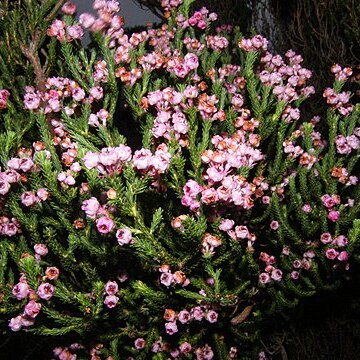Erect, entirely glabrous, 2-5 ft. high; branches numerous, ascending, subflexuous; leaves 4-nate, erect-incurved, imbricate, narrow-linear, subobtuse, sulcate, entire or obscurely serrulate, 2 1/2-3 1/2 lin. long; flowers terminal, 4-nate; pedicels 3 lin. long; bracts remote, lanceolate, keeled, scarious, coloured, 2-3 lin. long; sepals like the bracts but broad-lanceolate to obovate-oblong, acute, imbricate, keel-tipped, very concave, about 2 1/2 lin. long, mostly reaching to the length of the corolla-tube; corolla globose-urceolate, distinctly constricted at the throat, bluntly 4-gonous below with deep intermediate depressions between the angles, about 2 1/2 lin. long; segments short, broad, spreading, about 1/4 the length of the tube; filaments rather broad, bent below the anther; anthers included, lateral, broad-oblong, very obtusely rounded; cells completely divided, to below the base, each on a branch of the decurrent connective, and at length becoming subdistant, pale brown, about 1/2 lin. long, crested; pore large and wide, 2/3 the length of the cell; crests obliquely lanceolate-acuminate, serrulate, pallid, somewhat longer than the cell; style included, very short and stout; stigma capitellate or subsimple; ovary glabrous.
More
Glabrous shrub from c. 0.1-2.5 m high, usually erect, sometimes spreading. Lvs in whorls of 4, usually densely imbricate, curved and lying forward along stem, 4-9 mm long; margin revolute and contiguous, entirely concealing undersurface; apparent or false margin sometimes crenulate; petiole c. 1 mm long, appressed to shoot. Fls terminal, in clusters of (3)-4. Pedicels c. 5 mm long, pink and often obscured by the pink linear-oblong or lanceolate bracteoles overlapping the calyx. Sepals 4.5-5 mm long, elliptic-oblong or lanceolate-oblong, pink, keeled, ± mucronate. Corolla 5-6 mm long, globular, with 4 blunt-angled ridges and depressions between them, pink to rose, glabrous, constricted at apex; lobes short, broad, ± inflexed, sometimes deeper coloured than tube. Stamens included; filaments bent just below anthers, much > anthers; awns = or > anthers, fimbriate. Style included, short. Stigma capitate. Capsule c. 5 mm diam., almost globose, glabrous.
Erect, sturdy shrub to 3 m. Flowers small, calycine, globose, rose-pink.

